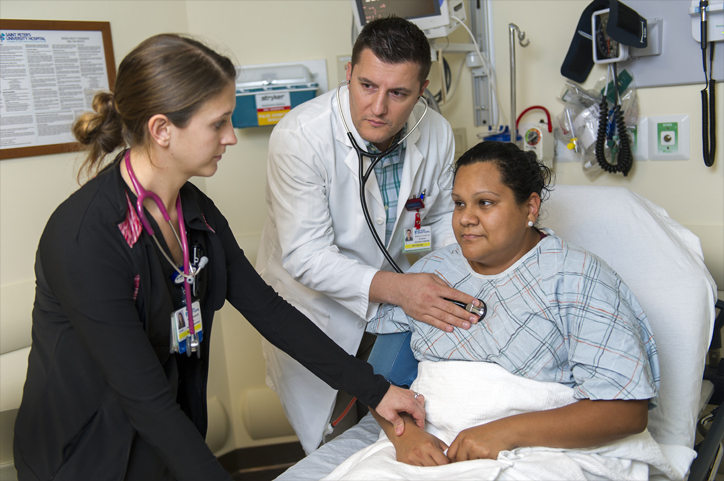A Speedier E.R.
The emergency department at Saint Peter's University Hospital offers enhanced patient comfort—and faster treatment.

The physicians and nurses who practice in the emergency department (ED) of Saint Peter’s University Hospital had two goals when they were asked to help design the renovation and expansion of their department. “First, we wanted to create a place that enabled us to practice the type of highest-quality emergency medicine we all envision,” explains Derek Schaible, M.D., interim chair of Emergency Medicine. “Second, we wanted to create an emergency department where we would want to be treated if we needed care.”
Judging from the rave reviews that have come in from both patients and staff, it seems these goals were met. The three-year, $17 million renovation—completed on time and within budget in August—has significantly increased the number of patients who can be treated, the speed and efficiency with which they’re seen and the breadth of services provided to them.
“Patients are particularly pleased with the ability to be seen in private rooms,” says Dr. Schaible. “Greater privacy increases the ease and candor with which patients share important information, enabling us to provide better care.” He explains that while the old ed had few private areas, the new department features 38 private rooms among its 56 patient-care areas. In the adult emergency department, five of those private rooms are dedicated to accommodating female patients with gynecologic issues.
 Before the renovation, notes Dr. Schaible, the ED could become crowd- ed during busy periods, and its physical facilities sometimes showed the strain of handling approximately 66,000 patient visits annually. With an expansion to 29,000 square feet, the newly renovated ed now can accommodate 85,000 patient visits a year, and the department has the design innovations and professional staff in place to ensure that those patients are seen quickly and treated efficiently.
Before the renovation, notes Dr. Schaible, the ED could become crowd- ed during busy periods, and its physical facilities sometimes showed the strain of handling approximately 66,000 patient visits annually. With an expansion to 29,000 square feet, the newly renovated ed now can accommodate 85,000 patient visits a year, and the department has the design innovations and professional staff in place to ensure that those patients are seen quickly and treated efficiently.
“One of the things we did in formulating the optimal design was to ‘choreograph’ a patient’s movement from the moment he or she arrived,” explains Heather Veltre, R.N., nursing director of emergency Medicine. “We put the plans up in the staff locker room and encouraged people to draw on them, write in suggestions, propose alternatives and offer other ideas for improving patient flow and experience.”
One result of that collaborative process is a system in which patients typically are brought directly to an ED bed for triage and registration. “The goal is to get the doctor and the patient together as quickly as possible, and this system enables us in many cases to have a patient seen by a physician within 10 to 13 minutes of arrival,” says Veltre.
Thanks to staff input as well, the new ED is divided into “pods” that focus on different medical situations. “This design allows us to immediately direct a patient to the area specifically designed to meet his or her needs,” explains Veltre. There is an adult critical care pod featuring technology and equipment for managing very serious injuries and illnesses, an adult rapid-treatment pod, a women’s health/gynecology pod, an adult fast-track pod and a large pediatric pod.
“The adult fast-track pod is designed to provide timely assessment and treatment of the sorts of complaints that often prompt people to visit stand-alone urgent care centers,” Dr. Schaible says. “The idea is to provide the same time-sensitive care as those facilities, but in a setting that offers the full resources of a hospital, should they be needed.”
Adults arriving with more serious conditions benefit from physical enhancements, equipment upgrades, and treatment protocols designed to provide immediate, optimal care in the ED and, as needed, other hospital departments. For example, the capacity of the ambulance entrance has been doubled so that four ambulances now can be accommodated at one time. Similarly, patient flow has been improved so that people experiencing acute coronary syndrome can be evaluated by a multidisciplinary emergency response team on arrival in the ED and then quickly be brought to the cardiac catheterization lab for emergency angioplasty.
"Greater privacy increases the ease and candor with which patients share important information, enabling us to provide better care."
—Derek Schaible, M.D.
Patients requiring urgent imaging studies can be transported promptly to the adjacent Radiology Department. “Our turnaround time on X-rays is under 30 minutes, and it’s less than 45 minutes for CT [computed tomography] scans and other imaging,” notes Dr. Schaible, adding that the hospital’s electronic medical record (EMR) system allows physicians, advanced practice clinicians and other healthcare professionals in the ED and throughout Saint Peter’s to readily access imaging reports, lab data and other information. The ED’s upgraded equipment includes all new cardiac monitoring equipment and defibrillators and a fiber-optic intubation device.
The full extent of the renovation’s enhancements is perhaps nowhere more evident than in the large, separated area dedicated to the treatment of children and adolescents. “It’s been completely transformed,” says Arnaldo Abreu, M.D., director of The Dorothy B. Hersh Pediatric Emergency Department. “On arrival, children and adolescents are brought immediately to the pediatric ED, which has its own distinct décor.”
There are 12 separate rooms for seeing children. “Patients and their parents are really pleased with the privacy that these rooms provide,” says Dr. Abreu, noting that patients who don’t feel well welcome the respite from the hustle and bustle of the ED.
 One of the pediatric ED’s rooms is designed for evaluating and treating patients with asthma, while another large room was built and equipped for pediatric resuscitation. “We treat patients with a wide range of complaints, including serious and potentially life-threatening illnesses and injuries,” says Dr. Abreu. “Having these specialized rooms and equipment, as well as ready access to the pediatric specialists of the children’s Hospital at Saint Peter’s University Hospital, enables us to provide optimal care to children and adolescents dealing with very serious situations.”
One of the pediatric ED’s rooms is designed for evaluating and treating patients with asthma, while another large room was built and equipped for pediatric resuscitation. “We treat patients with a wide range of complaints, including serious and potentially life-threatening illnesses and injuries,” says Dr. Abreu. “Having these specialized rooms and equipment, as well as ready access to the pediatric specialists of the children’s Hospital at Saint Peter’s University Hospital, enables us to provide optimal care to children and adolescents dealing with very serious situations.”
The pediatric ED now also offers the services of a full-time child life specialist. This specially trained professional interacts with patients in an age-appropriate way to calm fears, set expectations, share information and make the ED experience as stress-free as possible for patients and parents. “The value of the child life specialist is immeasurable,” says Dr. Abreu.
The renovation project began with the preparation of the initial design concept in may 2011. “The way this all came together really is a remarkable story,” says Robert Mulcahy, vice president of Facilities, Safety and Environment of Care at Saint Peter’s. “Our close collaboration with the ED staff not only enabled us to incorporate several key design features that reflect their expertise and experience, but also allowed us to complete the renovation without impacting ED use at any point. In fact, patients’ satisfaction with the care they received in the ED actually went up during the construction process.”
One design feature suggested by ED physicians is a spacious work station for their private-practice counterparts who come to the ed to see patients. “The ED team has a great working relationship with our colleagues in the community, marked by close communication regarding their patients,” says Dr. Schaible. “we wanted to enhance that collaborative approach by designating a work area where they could review charts, dictate notes, make phone calls and attend to other tasks.”
“In this and a hundred other ways, the design of the ed really is the staff’s design,” says Dr. Schaible, adding, “and the result is exactly what we set out to accomplish.” —Tom Garry


